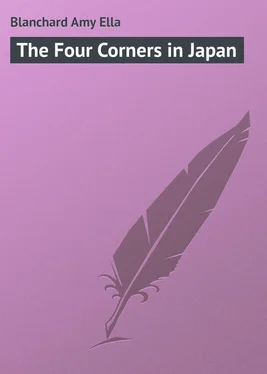Amy Blanchard - The Four Corners in Japan
Здесь есть возможность читать онлайн «Amy Blanchard - The Four Corners in Japan» — ознакомительный отрывок электронной книги совершенно бесплатно, а после прочтения отрывка купить полную версию. В некоторых случаях можно слушать аудио, скачать через торрент в формате fb2 и присутствует краткое содержание. ISBN: , Жанр: foreign_prose, на английском языке. Описание произведения, (предисловие) а так же отзывы посетителей доступны на портале библиотеки ЛибКат.
- Название:The Four Corners in Japan
- Автор:
- Жанр:
- Год:неизвестен
- ISBN:http://www.gutenberg.org/ebooks/45518
- Рейтинг книги:5 / 5. Голосов: 1
-
Избранное:Добавить в избранное
- Отзывы:
-
Ваша оценка:
- 100
- 1
- 2
- 3
- 4
- 5
The Four Corners in Japan: краткое содержание, описание и аннотация
Предлагаем к чтению аннотацию, описание, краткое содержание или предисловие (зависит от того, что написал сам автор книги «The Four Corners in Japan»). Если вы не нашли необходимую информацию о книге — напишите в комментариях, мы постараемся отыскать её.
The Four Corners in Japan — читать онлайн ознакомительный отрывок
Ниже представлен текст книги, разбитый по страницам. Система сохранения места последней прочитанной страницы, позволяет с удобством читать онлайн бесплатно книгу «The Four Corners in Japan», без необходимости каждый раз заново искать на чём Вы остановились. Поставьте закладку, и сможете в любой момент перейти на страницу, на которой закончили чтение.
Интервал:
Закладка:
"Stone lanterns," Mrs. Craig told her, "and yonder are the Buddha lions." She pointed out two strange, fantastic stone figures in sitting posture each side the way.
"And does Buddha live here?" asked Nan with a smile.
"He lives in many places," Mrs. Craig replied with an answering smile.
Just ahead they perceived three steps leading to a low edifice. Men and women were going and coming from these, stopping to kneel at the entrance of this, the temple which they had come to see. Most of these people tarried only a very short time, bending their heads in silent prayer for a few minutes, while they joined their hands reverently. Some clapped three times quite slowly, though noisily. There were many contributions made, small coins thrown into the big wooden box at the entrance.
The girls stood watching the worshippers curiously. "It would be interesting to know how much their offerings amounted to," said Mary Lee. "I suppose very little in our money."
"Very little indeed," responded their guide. "When you consider a rin is one-tenth of a sen and that a sen is only about equal to one of our cents you can see that a very small contribution suffices."
"What is inside the temple?" asked Nan.
"The shrine of Buddha, but he is not on exhibition except on feast days. If you go in you will have to take off your shoes, so perhaps we would better wait till some other time."
They decided that they would not attempt an entrance at this time, but they peeped through the paper-screened sides of the building to see a dim interior whose contents were in such obscurity that they could not make them out.
"Do you always have to take off your shoes before entering a temple?" asked Mary Lee.
"Oh, dear, yes, and not only upon entering a temple but before entering any house. You know all floors are furnished with soft matting rugs which it would never do to soil. When one considers how much mud and dust we carry into our homes on our shoes and skirts I am inclined to think the Japanese have more than one custom which we might adopt to advantage. If you want to see a tori-i , Miss Nan, I think we can find you one not very far away."
"I don't exactly understand what a tori-i really is," confessed Mary Lee.
"There are two theories concerning them," Mrs. Craig told her. "Many assert that they were originally perches for birds, one meaning of the word being a bird-rest, and it is supposed that they were used as a sort of altar on which fowls were offered to the gods; others maintain that the word means simply a gateway. One can easily see how either meaning could be accepted, for they do look like a perch as well as a gateway."
After another drive through a labyrinth of streets, where were queer little houses and queerer signs, they arrived at the bottom of another hill where again a flight of steps arose before them.
"Dear me," sighed Miss Helen, "I wonder if I am equal to all these climbs. I should like to import a few elevators for the sake of my American powers of climbing."
However, rather than be left behind, the ascent was decided upon by Miss Helen, Nan helping her up, and lingering with her when a pause for breath seemed advisable. At last they joined the other two who, more agile, had reached the spot before them. "So this is a tori-i ," said Nan looking up at the gateway. "Such a simple affair; just two upright pillars with two things across them. It might easily be a bird-perch. No carving, no letters, no anything, yet it is sort of impressive just because of its simplicity. Is there a temple beyond?"
"No, only a shrine," she was informed, "and probably closed."
"Then we shall not have to climb that second flight of steps," said Miss Helen in a relieved tone. "If one has to mortify the flesh in this manner before seeing temples, I am afraid I shall not see many."
"Oh, but you used to climb lots of steps in Europe," Nan reminded her. "How many were there in the duomo at Florence?"
"Don't ask me, my dear; the remembrance of them is still with me. Probably because I did climb so many in Europe is why I hesitate here, and perhaps the weight of years might be added as a second reason."
Nan frowned and shook her head. "You mustn't say that. You are as young as any of us."
"In spirit, maybe," her aunt returned with a smile.
"We certainly shall not expect you to see all the shrines and temples we come upon," Mrs. Craig told them, "for there are too many, and the best way is to select the most famous only to visit."
"We learned to do that way in Europe," said Nan. "One gets mental indigestion by tearing off to see every little thing, and finally one is so mixed up that nothing is remembered correctly."
"And if one lived here a lifetime it would be impossible to see all the sights or to learn all the legends," Mrs. Craig went on. "The best way is to get some well-written book and study up between times. You need to know a little of the folk-lore and something of the religions in order to understand the sights you wish to see. It will be impossible to get more than merely a very superficial idea even then, particularly upon the question of the two old beliefs of Shintoism and Buddhism."
"The Shinto belief is the worship of ancestors, isn't it?" asked Nan.
"It is founded upon that, as we understand it," Mrs. Craig explained. "Lafcadio Hearn probably can give you a better idea of what it means than I can, so I advise you to hunt up his books."
"We have some of them," Nan returned, "and I shall look up the subjects when we get home."
"Do all the Japanese adopt the Shinto creed?" asked Mary Lee.
"Oh, no, some are Buddhists, some are Christians, some have a mixed belief in which both Buddhism and Shintoism have a part. The ramifications are so numerous and so intricate that it would be impossible to explain them. I know only a very little myself, and I have been here three years. As to the language, it is hopeless. I shall never be at home with it, and there are only a very, very few foreigners who ever do master its intricacies. When you consider that every schoolboy is expected to learn six or seven thousand characters for daily use alone, and a scholar must know twice as many more, you may imagine the undertaking. Moreover there are several styles of writing these characters, so you may be glad you are not expected to master Japanese."
"Oh, dear," sighed Mary Lee, "it makes me tired merely to think of it."
After the climbing of so many steps, and after the fatigue following the constantly recurring sights which passed before their vision, they decided to go home and rest that they might be ready for their afternoon's entertainment. Their last sight of the tori-i was one they never forgot, for it framed the exquisite cone of Fuji as in a picture, and they were interested all the more when Mrs. Craig told them that these ancient gateways usually did form the framework for some special object such as a mountain, a temple, a shrine.
After having had luncheon and a good rest they were all quite ready for the next experience which Mrs. Craig had promised them. Eleanor who had been off with her brother all morning joined them in the afternoon's entertainment and was quite as much excited as the others to be a caller upon a really truly Japanese.
"It is such a pity," said Mrs. Craig, when they were about to start, "that you couldn't have been here in time for the Doll Festival which occurs upon the third of March. I am hoping, however, that the dolls will still be on view at the house where we are going, though they are usually stored in the go-down at the end of the three days."
"And what in the world is a go-down?" asked Eleanor.
"It is the family storehouse," her aunt told her. "Very little is kept out to litter up a Japanese house, where the utmost simplicity is considered desirable, so they have these storehouses in which all superfluities are kept. When you reach Mrs. Otamura's you will be surprised at the very absence of furnishings, but there, I must not tell you too much or you will not be sufficiently surprised."
Читать дальшеИнтервал:
Закладка:
Похожие книги на «The Four Corners in Japan»
Представляем Вашему вниманию похожие книги на «The Four Corners in Japan» списком для выбора. Мы отобрали схожую по названию и смыслу литературу в надежде предоставить читателям больше вариантов отыскать новые, интересные, ещё непрочитанные произведения.
Обсуждение, отзывы о книге «The Four Corners in Japan» и просто собственные мнения читателей. Оставьте ваши комментарии, напишите, что Вы думаете о произведении, его смысле или главных героях. Укажите что конкретно понравилось, а что нет, и почему Вы так считаете.












